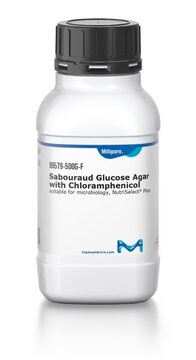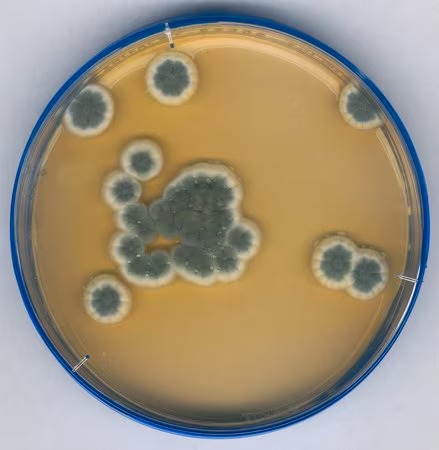Millipore® Sabouraud Dextrose Agar, GranuCult® plus, with Dextrose 4 %, Chloramphenicol, EP, USP, JP, granular
Catalog No :
CAS Number :
Brand :
In Stock
Specifications:
| Application | Microbiology | ||
| Storage Temperature | Ambient | ||
| Product Type | Culture Medium | Forms | Crystals |
| Product Brand | Millipore | ||
| Product Grade | Microbiology grade | ||
Millipore® Sabouraud Dextrose Agar, GranuCult® plus, is a nutrient-rich, selective culture medium designed for the isolation and growth of yeasts and molds. This formulation contains 4% dextrose and chloramphenicol, making it highly effective for promoting fungal growth while inhibiting bacterial contamination. The low pH and enriched composition facilitate the cultivation of various fungal species, including pathogenic and opportunistic fungi. This medium complies with the European Pharmacopoeia (EP), United States Pharmacopoeia (USP), and Japanese Pharmacopoeia (JP) standards.
Key Features & Benefits
- Selective Growth of Yeasts and Molds
- Supports the rapid and abundant growth of fungi, including dermatophytes, yeasts, and molds.
- Encourages spore formation (conidia and sporangia) and pigment production, aiding in fungal identification.
- High Dextrose Concentration (4%)
- Serves as a primary energy source for fungal growth.
- Enhances sporulation and colony development.
- Low pH for Optimal Fungal Growth
- Inhibits bacterial growth while favoring the proliferation of fungi.
- Helps maintain fungal culture viability and purity.
- Incorporation of Chloramphenicol (Antibiotic Supplementation)
- Prevents bacterial contamination, allowing for selective fungal isolation.
- Essential for samples containing high bacterial loads.
- Meets EP, USP, and JP Standards
- Ensures pharmacopoeial compliance for microbiological testing of non-sterile products.
- Suitable for quality control in pharmaceutical, food, and cosmetic industries.
Composition & Ingredients
| Component | Concentration |
|---|---|
| Peptones (digests of animal tissues) | Nutrient source for fungal growth |
| Dextrose (4%) | Energy source, supports sporulation and pigmentation |
| Chloramphenicol | Broad-spectrum antibiotic to inhibit bacterial growth |
| Agar | Solidifying agent for fungal culture |
| pH (at 25°C) | Low, favoring fungal growth and bacterial suppression |
Applications
- Isolation and cultivation of fungi (yeasts and molds) from clinical, environmental, and industrial samples.
- Microbiological examination of non-sterile products, including pharmaceuticals, cosmetics, and food products.
- Fungal contamination testing in industrial and research laboratories.
- Mycological studies, including the identification of dermatophytes and opportunistic fungi.
- Air and surface monitoring in cleanrooms, hospitals, and production facilities.
Storage & Stability
- Storage Conditions:
- Granular medium: Store upright, protected from light, at +15°C to +25°C.
- After first opening: Keep tightly closed in a dry place, usable until expiry date.
- Prepared agar plates: Store sealed in plastic bags at 2°C to 8°C, protected from light, for up to 2 weeks.
- Moisture Control:
- Avoid visible moisture on agar plates before use.
- If moisture is present, dry plates before use for the minimum time necessary.
Scientific Relevance & Use Cases
- Fungal Pathogen Identification:
- Used in clinical diagnostics to detect fungal infections such as Candida, Aspergillus, and dermatophytes.
- Helps in the differentiation of fungal species based on morphology, pigmentation, and spore formation.
- Quality Control in Industrial Microbiology:
- Ensures fungal contamination-free pharmaceutical, cosmetic, and food production.
- Compliant with global pharmacopoeial standards for non-sterile product testing.
- Environmental Monitoring & Research:
- Applied in air sampling for fungal spores in hospitals, laboratories, and production areas.
- Used in agriculture and food industry microbiology for detecting spoilage fungi.
The Millipore® Sabouraud Dextrose Agar, GranuCult® plus is an advanced selective fungal culture medium optimized for mycological applications. With high dextrose content, low pH, and antibiotic supplementation (chloramphenicol), it effectively supports fungal growth while inhibiting bacterial contaminants. It is widely used for pathogenic fungi detection, contamination control in industrial settings, and research in mycology. Its compliance with EP, USP, and JP makes it a reliable and standardized medium for various microbiological applications.




 0
0





